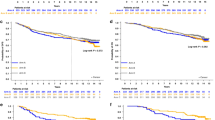Play all audios:

ABSTRACT To determine if chemotherapy dose intensity influences treatment outcome in advanced ovarian cancer, all randomised studies of first line chemotherapy, published between 1975 and
1989, were analysed for relationships between planned dose intensity and (a) objective response and (b) median survival. Total dose intensity of each study regimen was calculated and a
weighted regression model providing for systemic differences in response or survival among studies was utilised. Hence, treatment arms of different studies were never directly compared. In
addition, relative dose intensities of individual drugs within combinations was similarly evaluated. The improvement in objective response rate when adding one unit of total dose intensity
ranged between 12% and 16% depending on baseline response rate. The improvement in median survival when adding one unit of total dose intensity ranged between 2 and 4 months. One unit of
total dose intensity corresponds to, for example, 20 mg m2 week of cisplatin, or 25 mg m2 week of doxorubicin, or 350 mg m2 week of cyclophosphamide. The analysis of individual drugs
suggested that doxorubicin and the platinum compounds were about equally effective, with cyclophosphamide being less effective. The methodological benefits and limitations of the approach
used and the implication of the results are discussed. Access through your institution Buy or subscribe This is a preview of subscription content, access via your institution ACCESS OPTIONS
Access through your institution Subscribe to this journal Receive 24 print issues and online access $259.00 per year only $10.79 per issue Learn more Buy this article * Purchase on
SpringerLink * Instant access to full article PDF Buy now Prices may be subject to local taxes which are calculated during checkout ADDITIONAL ACCESS OPTIONS: * Log in * Learn about
institutional subscriptions * Read our FAQs * Contact customer support SIMILAR CONTENT BEING VIEWED BY OTHERS DOSE-DENSE SEQUENTIAL ADJUVANT CHEMOTHERAPY IN THE TRASTUZUMAB ERA: FINAL
LONG-TERM RESULTS OF THE HELLENIC COOPERATIVE ONCOLOGY GROUP PHASE III HE10/05 TRIAL Article 24 May 2022 GAIN2 TRIAL OVERALL SURVIVAL WITH INTENSE VERSUS TAILORED DOSE DENSE CHEMOTHERAPY IN
EARLY BREAST CANCER Article Open access 30 July 2024 IMPACT OF DOSE REDUCTIONS ON ADJUVANT ABEMACICLIB EFFICACY FOR PATIENTS WITH HIGH-RISK EARLY BREAST CANCER: ANALYSES FROM THE MONARCHE
STUDY Article Open access 26 April 2024 AUTHOR INFORMATION AUTHORS AND AFFILIATIONS * Instituto di Ricerche Farmacologiche Mario Negri, Milano, Italy V Torri Authors * V Torri View author
publications You can also search for this author inPubMed Google Scholar * EL Korn View author publications You can also search for this author inPubMed Google Scholar * R Simon View author
publications You can also search for this author inPubMed Google Scholar RIGHTS AND PERMISSIONS Reprints and permissions ABOUT THIS ARTICLE CITE THIS ARTICLE Torri, V., Korn, E. & Simon,
R. Dose intensity analysis in advanced ovarian cancer patients. _Br J Cancer_ 67, 190–197 (1993). https://doi.org/10.1038/bjc.1993.33 Download citation * Issue Date: 01 January 1993 * DOI:
https://doi.org/10.1038/bjc.1993.33 SHARE THIS ARTICLE Anyone you share the following link with will be able to read this content: Get shareable link Sorry, a shareable link is not currently
available for this article. Copy to clipboard Provided by the Springer Nature SharedIt content-sharing initiative
